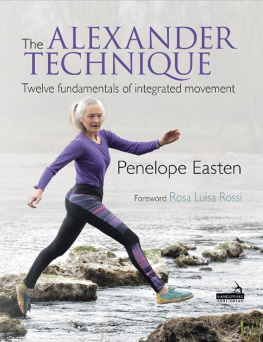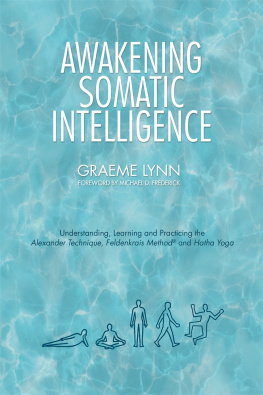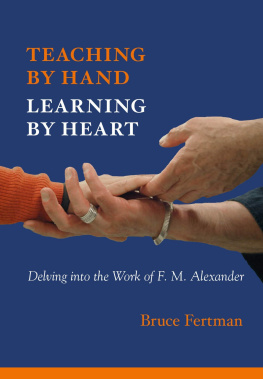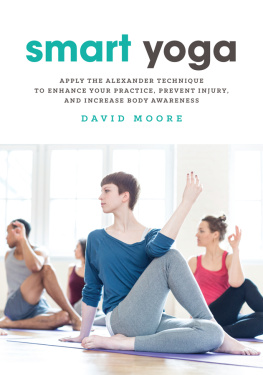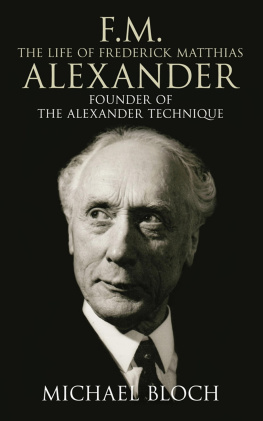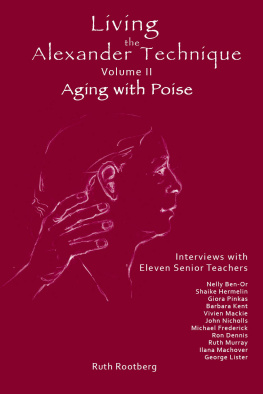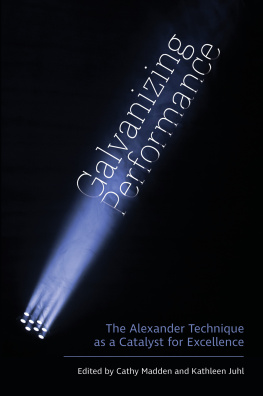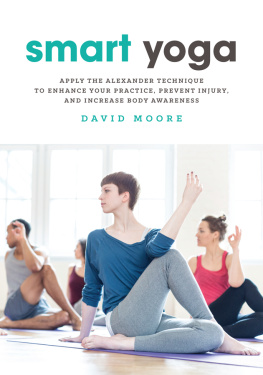Contents
Guide
Page List
Praise for The Alexander Technique: Twelve fundamentals of integrated movement
There are many books in the marketplace about the Alexander technique, but this one is unique.
It provides a distillation of a lifetime of learning, practice, study, teaching and critical thinking. Penelope understands and explains the history and development of the Alexander technique and is not constrained by any one school or interpretation. Her original training in the technique was a standard hands-on training, and she has widened her horizons through her substantial subsequent study with remarkable teachers Miss Goldie and Jeando Masoero come to mind.
In addition, she brings insights and knowledge from a wide range of scientific discoveries and mind/body disciplines which have developed since Alexanders time. And she weaves them into the intellectual and practical explorations which she offers to readers of this book. You might even call her book a contemporary update of the Alexander technique.
This is a book that you will keep coming back to, and working with. It provides rich experiential and intellectual sustenance and will certainly go onto the essential reading list for my Alexander trainees and on the highly recommended list for my yoga and Alexander students.
David Moore, Director of the School for F.M. Alexander Studies, Melbourne, Australia
Author of Smart Yoga: Apply the Alexander technique to enhance your practice, prevent injury, and increase body awareness
www.alexanderschool.edu.au/
Nowadays it is a well-known fact that musicians are particularly at risk from overuse injuries and anxiety or stress-related conditions. As a faculty member in a university music department, I have been delighted with the immediate positive impact the ideas presented in Penelope Eastens The Alexander Technique: Twelve fundamentals of integrated movement have had for the students in my Alexander technique class. No musician should be without a copy of this book. Read and study it, taking time to explore the various elements presented, and you will have the keys not only to wellness and reduced performance anxiety but also to enhanced musical technique and performance standard through an integrated and responsive body.
Alison P. Deadman, PhD, teacher of the Alexander technique, Professor of Music
This book is a treasure. In comprehensible language it helps us understand the multi-faceted science of the human body along with its functional anatomy, but at the same time it is very practically orientated. It provides a vast number of procedures for self-exploration which are also tools to teach students and groups. This book will become the modern encyclopaedia for Alexander technique teachers, bodywork practitioners of any kind, for the performing arts and for anyone interested in human nature.
In my practice as an Alexander technique teacher for actors, I find this profound work helps to free the actors or singers instrument. It unlocks natural breathing, free flow of emotions, and a more embodied way of speaking and thus enables the performer to come from a more truthful, authentic place.
Annedore Kleist, actor and Alexander technique teacher, Berlin
www.annedorekleist.com
Ms Easten offers us an experiential, dynamic re-framing of F.M. Alexanders principles, rooted in biomechanics, neurophysiology, decades of experience, and PLAY! Her work is a must-have in the toolkit of any Alexander technique teacher, movement educator, or somatic professional who works virtually or in-person.
Im an open-minded skeptic and a teacher of 14 years with strong classical Alexander training. Working with Ms Easten has upped both my in-person and online teaching game, deepened my anatomy understanding, as well as given me greater confidence. I am profoundly grateful for her gift to the future of the technique.
Rebecca Poole, cAmSAT, mACAT
www.NYalexandertechnique.com
Penelope is a humble genius with an incredible depth of knowledge and creative flair, making her innovating work exciting and irresistible! Working with Penelope has filled in the missing pieces of my Alexander technique jigsaw puzzle. I have now learned how to have appropriate tone without tension and stability without stiffness. As a classical dressage rider, this has hugely improved my back and seat, making me a much more effective rider, and I cannot thank Penelope enough for her wonderful pioneering work. I look forward to sharing these skills with other passionate riders.
Chris English, Alexander technique teacher and classical dressage rider and coach
www.riderselfcarriage.co.uk
The Alexander Technique: Twelve fundamentals of integrated movement is a rich body of work in an accessible format that keeps delivering whenever you review. It is deep work and a great asset to self-understanding and self-care. So relevant for now!
Penelope has brought Alexanders technique totally up to date. I have found the structure and format of the book has enabled me to teach AT remotely even more effectively than before. Her functional anatomy teachings offer us simple ways of improving our strength, vitality, poise. Our whole self is nourished with anatomical knowledge that aids better self-understanding.
My teenage pupils have appreciated the repeatable format enabling and empowering them to effectively apply this work to themselves during any activity. In particular, my Music Scholar pupils have benefitted greatly, introducing it as part of their Alexander practice and reaping the rewards of balanced, natural, and dynamic postural tone, essential knowledge to support a long term career as a musician in good health.
Medical imaging practitioners would be well-placed to follow Penelopes teaching; their detailed understanding of anatomy and all its different systems will enable them to build a self-care strategy themselves to help avoid the RSI and WRMSDs that are commonplace in this field.
Angela Bradshaw, MSTAT, DMU, DCR(R)
Author of Be In Balance, published by Balloon View, UK, 2014.
TEDxSWPS Show Me How. DMU, Diploma in Medical Ultrasound; DCR(R), Diploma in Diagnostic Radiography; Alexander technique teacher
www.angelabradshaw.com
Finally, a comprehensive manual for Alexander technique teachers to work with clarity on biomechanics and neurological aspects of the discipline and to understand the roots of its different approaches.
Penelope Easten also provides to professionals of the somatic field in general a complete guide on postural alignment and anatomy of movement: beautifully explained and precise on theory and practical explorations, it undoubtedly is a precious tool for training courses both for Alexander technique and Yoga teachers.
Sara Carissimo, statistician and expert in sociology of health and non conventional medicines, Alexander technique and alignment-based yoga teacher
www.yogabodylab.com
Penelope Eastens book has been an eye-opener for me and my training course students. So many new ideas such as Ive never encountered in 25 years of teaching are inspiring me to look forward to the next 25 years! The new ways of understanding F.M. Alexanders work are contributing to a deeper understanding of how I teach my training course, group classes, and private students. The author takes Alexanders concepts of direction to a new level, bringing about an incredible coordinative strength in carrying out activities. No other course of study has influenced me more in how I approach teaching my trainees, groups, and private students

